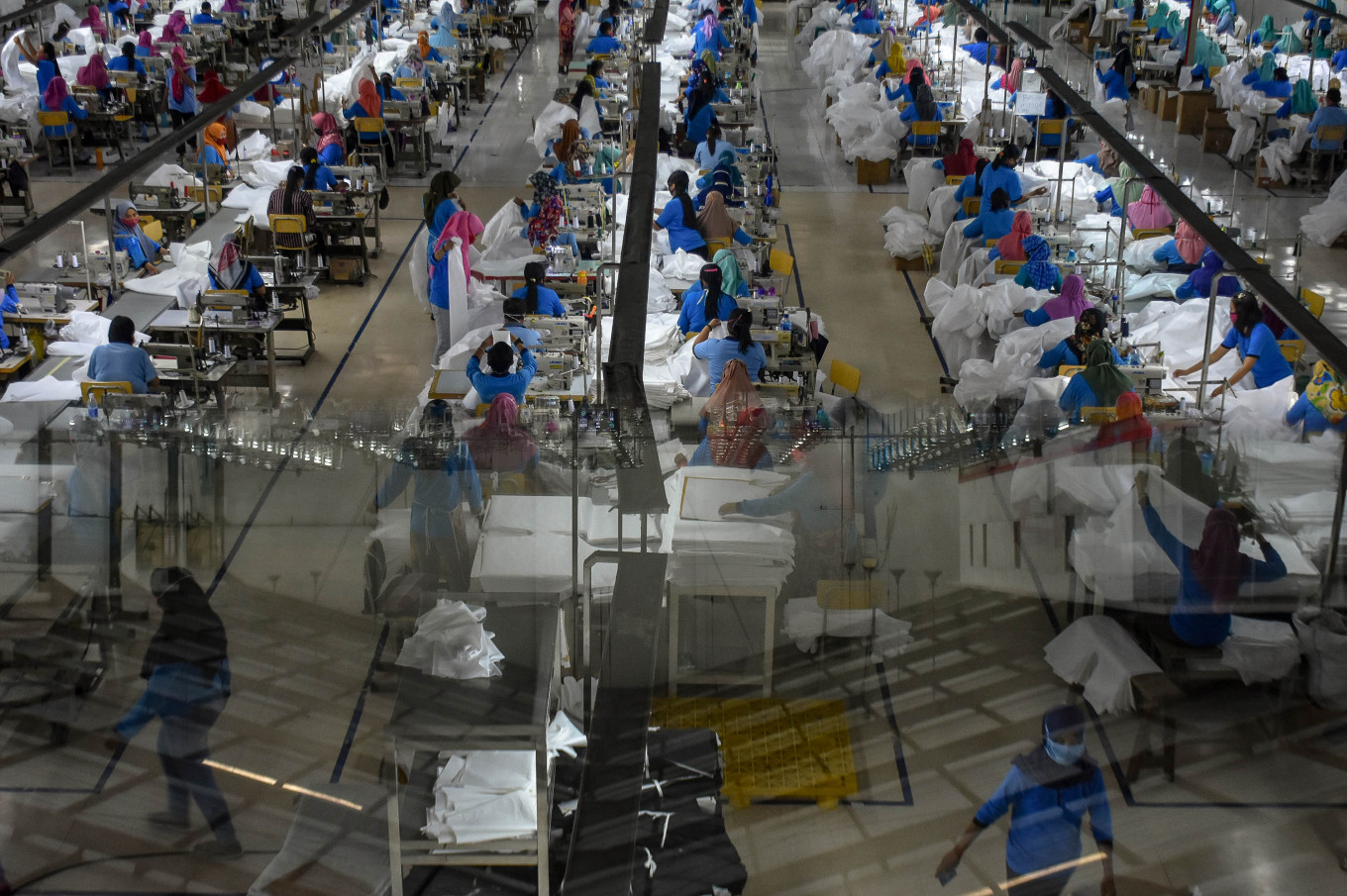Popular Reads
Top Results
Can't find what you're looking for?
View all search resultsPopular Reads
Top Results
Can't find what you're looking for?
View all search resultsManufacturers adapt to shifts in demand but layoffs continue
Industry Minister Agus Gumiwang Kartasasmita said the industrial landscape was changing during the pandemic with some industries thriving and others suffering.
Change text size
Gift Premium Articles
to Anyone
 Workers produce personal protective equipment (PPE) at a PT Kasih Karunia Sejati factory in Malang, East Java, on Monday. Industry Minister Agus Gumiwang Kartasasmita said the industrial landscape was changing during the pandemic with some industries thriving and others suffering. (JP/ Aman Rochman)
Workers produce personal protective equipment (PPE) at a PT Kasih Karunia Sejati factory in Malang, East Java, on Monday. Industry Minister Agus Gumiwang Kartasasmita said the industrial landscape was changing during the pandemic with some industries thriving and others suffering. (JP/ Aman Rochman)
W
hile a number of large manufacturing companies are adapting to the shifts in demand toward health equipment and basic necessities during the COVID-19 pandemic, widespread layoffs and furloughs have still been seen with small and medium-sized manufacturers struggling.
Industry Minister Agus Gumiwang Kartasasmita said the industrial landscape was changing during the pandemic with some industries thriving and others suffering while the government was looking to strike a balance between keeping the economic engine running and curbing the spread of COVID-19.
“We’ve provided stimulus packages and support to keep the manufacturing sector running because it’s the largest contributor to the national economy with a 19 percent share,” Agus told reporters during an online press briefing on Tuesday.
According to the ministry’s data, 60 percent of manufacturers have been hit hard by the pandemic, while the rest have seen moderate or high demand. Demand has increased for personal protective equipment (PPE), medical equipment, pharmaceutical products and food and beverages, while the petrochemical sector has also seen moderate demand.
A recent survey by the Mobile Marketing Association (MMA) and SurveySensum found that 85 percent of respondents were washing their hands more frequently, while 46 percent said they were taking vitamin supplements, indicating a shift in consumer behavior. The survey findings were in line with retailers’ reports of a hike in demand for hygiene products.
The changes in demand have pushed manufacturers to shift their production lines to make high-demand products.
Plastic part producer PT Yogya Presisi Tehnikatama Industry (YPTI) and robotics company PT Stechoq Robotika Indonesia have joined hands with Gadjah Mada University in Yogyakarta to produce 600 high-grade ventilators per month. The consortium plans to start production in May.
State-owned weapons manufacturer PT Pindad, electronics producer PT LEN and airplane producer PT Dirgantara Indonesia have also joined forces to produce ventilators. The three companies worked with the Bandung Institute of Technology to produce 10,000 emergency ventilators by mid-April, according to Industry Ministry data.
Textile companies have also been quick to adapt to changes in demand by producing much-needed PPE and masks.
“With 28 textile companies that have switched their production lines to produce PPE, we can now produce 1.8 million pieces of PPE per week. We can also produce 20 million medical-grade masks per week,” the Industry Ministry’s chemical, pharmaceutical, and textile industry director general, Muhammad Khayam said.
While some companies have been able to adapt, Agus said not all industries would be able to weather the crisis unscathed.
“In the textile sector, large producers can shift from producing garments to producing PPE. However, not all companies can shift their lines of production so quickly,” Agus said.
In the textile sector, he said, four large companies had been able to export US$3 billion in products during the pandemic. However, 1.5 million workers have still been furloughed, with the majority having worked for small and medium-sized textile companies.
“The majority of the industry is suffering, but things are worse for small and medium-sized manufacturers. We will start collecting data on the number of layoffs and coordinate with the Office of the Coordinating Economic Affairs Minister to provide workers with preemployment card benefits,” he said.
Around 2.8 million people have lost their jobs so far, according to data from the Manpower Ministry and the Workers Social Security Agency (BPJS Ketenagakerjaan).
Meanwhile, IHS Markit announced on April 1 that Indonesia’s PMI, the gauge for manufacturing activities, had slumped to 45.3, the worst in the survey's nine-year history. An index reading above 50 reflects an expansion, while a value below 50 indicates a contraction.
The situation could get worse as Indonesia’s economy is projected to see sluggish growth, Agus said.
“If our economic growth reaches 2.4 percent, then our [industrial] growth could hover around 2.5 to 2.6 percent. However, if our economy only grows by 0.5 percent, we will adjust the manufacturing industry growth projection to around 0.7 to 0.8 percent,” he said.
The government projects the country’s economy to grow 2.3 percent this year under a baseline scenario and even contract 0.4 percent under a worst-case scenario. The International Monetary Fund (IMF) recently slashed its projection for Indonesia’s GDP growth to 0.5 percent, which would be the lowest growth rate since the 1998 financial crisis, from 5.1 percent in its October projection.









